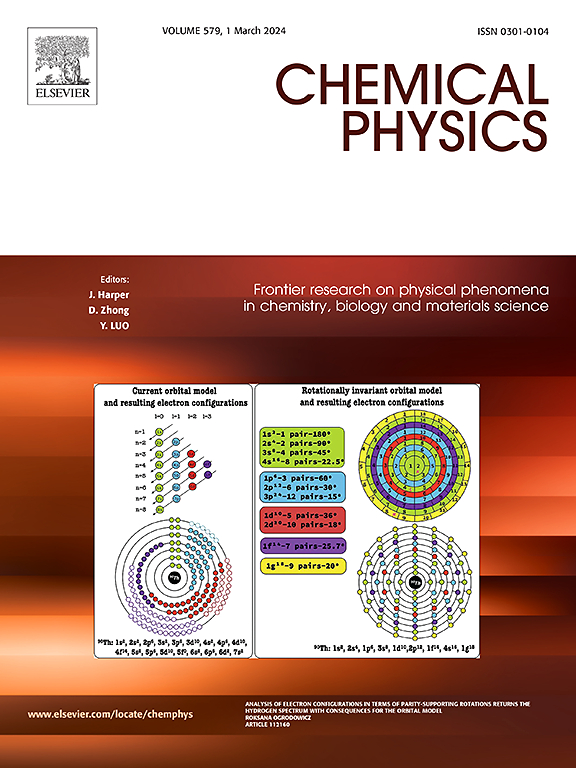Unveiling the physical properties of group III-nitride ultrawide band gap semiconductors: β-naphthyldiene, graphenyldiene, and β-naphthylene-based monolayers
IF 2.4
3区 化学
Q4 CHEMISTRY, PHYSICAL
引用次数: 0
Abstract
We introduce six new ultrawide band gap semiconductor monolayers based on graphenyldiene (IGPD) and -naphthylene (INP) frameworks, incorporating III-nitride compounds (AlN, BN, and GaN). Additionally, we propose a porous structure, naphthyldiene (INPD), which integrates features from both frameworks. The optimized unit cells exhibit distinct symmetries: IGPD-AlN, IGPD-BN, and IGPD-GaN show hexagonal (No. 189) space group, while INP-BN, INP-AlN, and INP-GaN adopt the rectangular (No. 51) symmetry. The INPD monolayers, which combine the features of both the IGPD and INP structures, stabilize in the orthorhombic (No. 38) space group. Phonon calculations confirm the absence of imaginary modes, demonstrating dynamical stability, while ab initio molecular dynamics simulations at 300 K indicate thermal robustness, with energy fluctuations below 1 eV/atom. Electronic structure calculations reveal band gaps ranging from 4.15-7.31 eV. Furthermore, all monolayers satisfy the Bohr-Huang stability criterion. Mechanical analysis indicates that INP-based monolayers exhibit the highest Young’s modulus, with INP-BN reaching 240.37 N/m, followed by INP-AlN (130.06 N/m) and INP-GaN (113.67 N/m). These results highlight the potential of the proposed monolayers in rigid and transparent high power electronics and deep ultra-ultraviolet radio frequency electronics applications.

揭示iii族氮化超宽带隙半导体的物理性质:β-萘二烯、石墨烯二烯和β-萘基单层
我们介绍了六种基于石墨烯二烯(IGPD)和β-萘(INP)框架的新型超宽带隙半导体单层,其中含有iii -氮化物(AlN, BN和GaN)。此外,我们提出了一种多孔结构,萘二烯(INPD),它集成了两个框架的特征。优化后的单元格具有明显的对称性:IGPD-AlN、IGPD-BN和IGPD-GaN具有六边形的P6¯m2 (No. 189)空间群,而INP-BN、INP-AlN和INP-GaN具有矩形的Pmma (No. 51)对称。INPD单层膜结合了IGPD和INP结构的特点,稳定在正交Amm2 (No. 38)空间群中。声子计算证实了虚模的不存在,证明了动力学稳定性,而从头算分子动力学模拟在300 K下显示了热鲁棒性,能量波动低于1 eV/原子。电子结构计算显示带隙在4.15-7.31 eV之间。此外,所有的单分子膜都满足Bohr-Huang稳定性判据。力学分析表明,INP-BN的杨氏模量最高,达到240.37 N/m,其次是INP-AlN (130.06 N/m)和INP-GaN (113.67 N/m)。这些结果突出了所提出的单层材料在刚性和透明高功率电子器件和深紫外射频电子器件中的应用潜力。
本文章由计算机程序翻译,如有差异,请以英文原文为准。
求助全文
约1分钟内获得全文
求助全文
来源期刊

Chemical Physics
化学-物理:原子、分子和化学物理
CiteScore
4.60
自引率
4.30%
发文量
278
审稿时长
39 days
期刊介绍:
Chemical Physics publishes experimental and theoretical papers on all aspects of chemical physics. In this journal, experiments are related to theory, and in turn theoretical papers are related to present or future experiments. Subjects covered include: spectroscopy and molecular structure, interacting systems, relaxation phenomena, biological systems, materials, fundamental problems in molecular reactivity, molecular quantum theory and statistical mechanics. Computational chemistry studies of routine character are not appropriate for this journal.
 求助内容:
求助内容: 应助结果提醒方式:
应助结果提醒方式:


